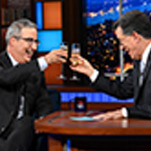8 Decades, 8 Roles: The Incredible Durability of James Hong
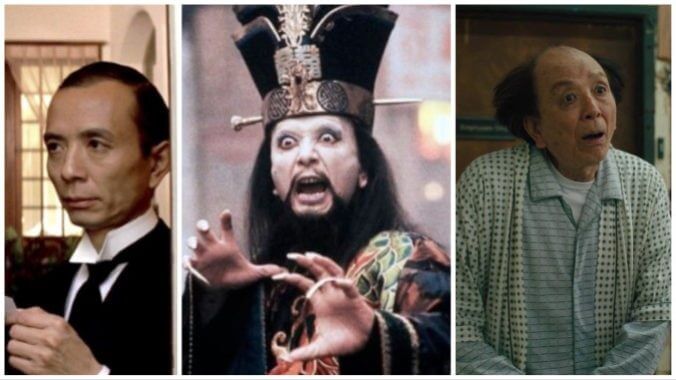
In the world of cinema, there are character actors, and there are prolific character acting icons, and then there’s James Hong.
Hong is one of those rare individuals whose career and presence transcends the medium in which he has so often appeared over the years. Now 94 years old, and without a doubt more widely known and respected in this moment than ever before, the man is still performing in high-profile roles like 2022’s Everything Everywhere All at Once, a full 70 years after first stepping in front of the camera in the early 1950s. Spanning eight decades, James Hong’s career has been an absolute model of consistency, never once stepping away from cinema, TV or voice acting for long. In the process, he’s become by some accounts the most prolific character actor in history, though such things are difficult to quantify. We know this: James Hong has appeared in more than 600 roles to date, and he’s still not stopping. If someone else has a more sprawling filmography, we haven’t yet seen it.
At the same time, we should acknowledge the realities of Hong’s fight for relevancy as an actor over the decades: He may have appeared in 600 roles, but the vast majority of those are small cameos with credited names such as “Asian General,” “Waiter #3” or “Old Chinese Man,” especially in the first half of his career. It’s not as if a great collection of meaty parts was always available to him, or actors in Hollywood who looked like him. But he seemingly never let this discourage him; Hong has played whatever was available to him, for the love of the craft. He’s played Chinese. He’s played Japanese. He’s played Korean. He’s probably played far more besides. If someone claims to have seen all the man’s roles, they’re probably lying.
It’s this indefatigable nature that slowly but surely built James Hong into an icon, culminating in some of his breakthrough performances in the 1970s and 1980s, followed by a decades of status as a beloved film geek icon. From the 1990s onward, casting James Hong seemed to become an industry handshake, an acknowledgement of the hard-working actor’s dogged persistence and infectiously optimistic spirit. He truly is the consummate Hollywood character actor, and you can never really acknowledge this type of performer enough.
So with that in mind, we thought now would be a fitting time to crawl back through Hong’s incredibly vast filmography, in order to pick one film (or other project) from each decade that highlights the man’s talents. Consider this a guided tour through eight decades of James Hong cinema.
1950s: Godzilla: King of the Monsters, 1956
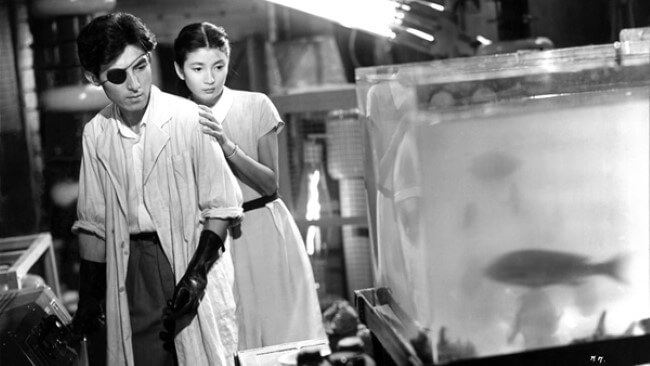
James Hong’s early acting career effectively began as a side gig, during the years he spent using his college degree in civil engineering to make a living. After serving as an entertainer in the military during the Korean War, Hong moved to L.A., where he could work as a road engineer by day and pursue acting jobs whenever he wasn’t making a “legitimate” living. After more than five years of toiling away in this manner, he quit engineering for good to focus on acting–not a bad decision, 70 years later.
I must confess, I was genuinely surprised to find–as both a Hong fan and a lifelong Godzilla fan who has ranked every film in the kaiju series for Paste–that one of James Hong’s most notable early roles was providing English dubs for the American localization of Ishiro Honda’s iconic 1954 monster movie Gojira. That film is 1956’s Godzilla, King of the Monsters!, and Hong’s involvement here may not be as widely known as one would expect because the film has never had the greatest reputation: It clumsily attempts to westernize the somber, frequently horrifying Japanese original by cramming in a new American viewpoint character played by Raymond Burr, with producers seemingly thinking that a white protagonist was necessary to engage American audiences. Suffice to say, this version is rarely seen today.
Hong, however, isn’t just playing assorted background characters–though he does provide numerous voices here. Notably, he’s providing the English dub for the character of Dr. Serizawa–the high-minded and noble scientist who stumbles upon the key to creating the Oxygen Destroyer, a superweapon used to kill the original Godzilla. It’s pretty neat that Hong was able to stake his indirect claim to what is arguably Godzilla’s most iconic human role, a character that would eventually be portrayed by the equally loved Ken Watanabe in Legendary’s reboot of the Godzilla franchise in the 2010s. Certainly, this role remains more culturally significant for Hong than most of the other bit parts he was playing at the beginning of his career in the 1950s.
1960s: The Bamboo Saucer, 1968
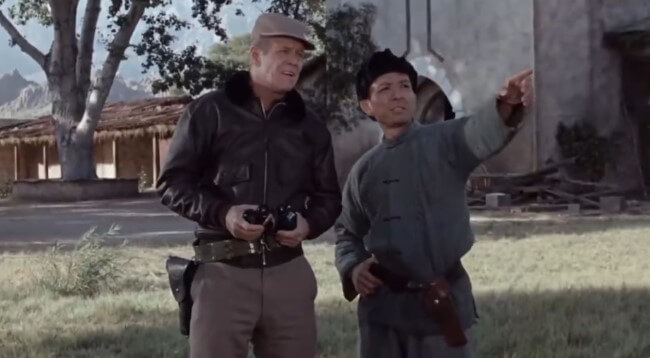
The 1960s is arguably the most difficult decade to find a real role of consequence in the career of James Hong, as he was largely confined to small appearances, being particularly prolific in playing bit parts and characters on TV series throughout the decade–though he also spent time creating the influential Asian American theater organization East West Players. He does, however, have a fairly major role in the low-budget, independently made 1968 Cold War science fiction drama The Bamboo Saucer. This is a stuffy military drama mixed with sci-fi adventure, mostly notable today for some laughably bad visual effects, even for its era. Considering that Mystery Science Theater 3000 once hosted something like 1964’s The Starfighters, this film would have been right at home alongside it.
The Bamboo Saucer is about a team assembled by the American government to perform a covert/stealthy scientific mission into Communist China, in order to locate a downed flying saucer that is being hidden from the Chinese government. On the way, the American team encounters a similar Russian team trying to do the same thing, leading to the two groups forming an uneasy alliance. Hong, meanwhile, is playing an American agent who has been undercover in China, waiting to guide the American team once they arrive.
Watching James Hong in The Bamboo Saucer, it’s hard not to note his interesting delivery here–he sounds the “least Chinese” of any role I’ve ever seen him in, as if he was trying to hide any hint of an accent, perhaps in an effort to show American casting directors that he could. It regardless seems a bit odd coming from an American agent who is undercover in China, and thus expected to blend in as perfectly as he can, but I digress. He has a chance here to essentially play the local expert on the “Commies,” which he never misses an opportunity to call them. After leading the group to the flying saucer–hidden in a Catholic church of all places–Hong’s character largely slips into the background, though he does get a heroic and action-packed end when Chinese soldiers arrive on the scene. He even gets to throw grenades and shoot down waves of COMMIES during the climactic action scene, before the requisite heroic death to buy time for the white American protagonists. It’s definitely a more meaty role than much of what Hong was being offered in the 1960s.
1970s: Chinatown, 1974
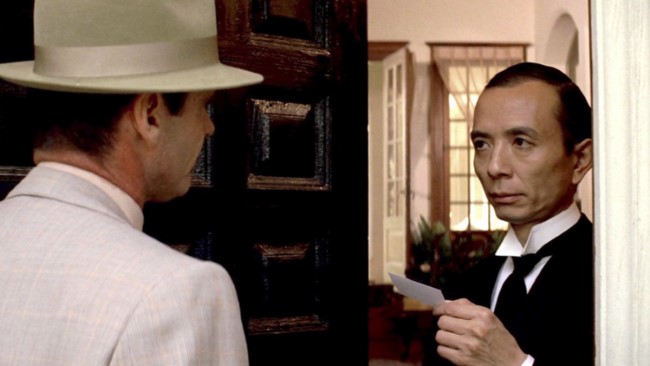
There are more options overall for a James Hong role to spotlight in the 1970s, and even some major roles in little-remembered films. A good contender would have been 1972’s The Carey Treatment, in which Hong plays a wrongfully accused doctor who is alleged to have performed an illegal abortion leading to a woman’s death. He spends that film in prison while the protagonist, played by the great James Coburn, works to secure his release.
We’ll go, however, with Hong’s small but highly visible role in what is frequently regarded as one of the greatest noir films ever, Chinatown. For one thing, his butler character Khan is one of the only people in the film to actually reside or have resided in the titular Chinatown, much in the same way that Hong himself grew up in Minneapolis’ Chinese neighborhood. He plays a small but pivotal role as the effective guardian and caretaker of the mysterious Evelyn Mulwray, being privy to some of her truly twisted family secrets. Khan also attempts to help spirit Evelyn and her … sister … away from antagonists in an ill-advised escape at the end of the film–suffice to say, it doesn’t exactly turn out well.
Jack Nicholson reportedly admired Hong’s performance so much that he brought him back again as Khan in 1990’s less-loved sequel The Two Jakes, which Nicholson also directed. For James Hong, though, his recognizability was growing and about to pay off in the 1980s.
1980s: Big Trouble in Little China, 1986
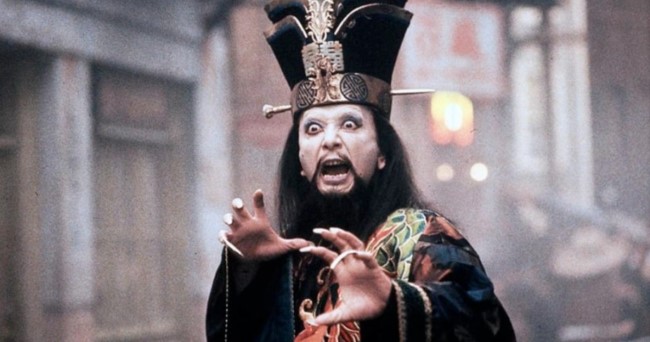
After decades of playing bit parts and background characters, the 1980s was the decade when Hong’s hard work started to pay off with far more visible roles, several of them in films that have gone on to be hailed as all-time classics. It’s impressive in retrospect how Hong manages to pop up in very disparate genres as he constantly works: In this one decade, he makes small appearances in legendary comedies like Airplane!, followed by B-movie nonsense like Ninja 3: The Domination, cop films like Tango & Cash and thrillers like Black Widow. One of the most visible roles in the memories of film geeks, though, would be that of replicant eyeball specialist Hannibal Chew in Ridley Scott’s Blade Runner, which sees Hong facing off with Rutger Hauer’s Roy Batty as the replicant searches for information on how to overcome his upcoming expiration date.
At the end of the day, though, you can’t choose any other film from the 1980s to spotlight other than Big Trouble in Little China, likely the most iconic and important role in Hong’s entire career. One part ancient, cursed sorcerer and another part semi-modern mob boss, his David Lo Pan represents the perfect synthesis of James Hong’s humor, affability and menace. Presiding over a magical underground of San Francisco’s Chinatown, he has an eye-popping array of warriors and monsters at his beck and call, even though Lo Pan himself is tenuously holding on to a very fragile grasp on corporeality. This serves to make Lo Pan a memorably odd antagonist, one who is by some measurements extremely powerful but simultaneously quite vulnerable and almost pitiable. Hong brings his unique brand of verve to the task, in what is overall actually one of his funniest performances.
In the decades to come, it’s appreciation for the likes of Big Trouble in Little China that eventually made James Hong into a cult figure, extending his career well past the point when almost all actors have called it quits.
1990s: The Perfect Weapon, 1991
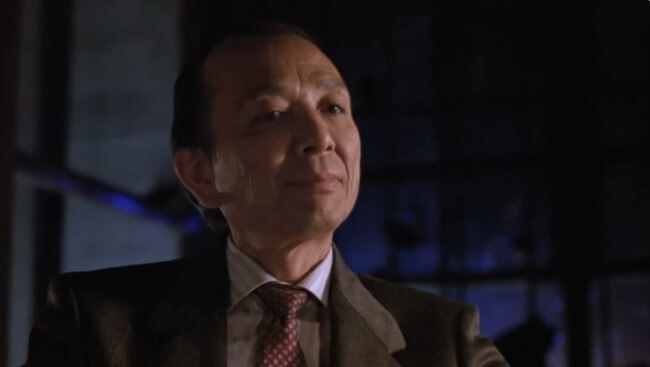
James Hong found himself in a groove in the 1990s, with seemingly more film and TV work than he knew what to do with. He pops up in a rather incredible number of B-movies here in particular, including our selection The Perfect Weapon, but he also spends the decade expanding his voice acting work and making TV guest star appearances that are fondly remembered decades later. Perhaps the most enduringly famous is in Seinfeld’s classic bottle episode “The Chinese Restaurant,” in which he plays the irritating maître d’ who antagonizes the anxious group by repeatedly assuring them that the table will be ready in “five, ten minutes,” an interminable period that never seems to decrease. Disney fans of the era may also have been introduced to Hong’s distinctive voice in 1998’s Mulan, in which he plays the scheming, belligerent advisor to the Emperor, Chi-Fu. Also very fun: His zany appearance in Wayne’s World 2, which gives him a chance to engage in a full-on kung fu parody battle with Mike Myers.
The Perfect Weapon, on the other hand, perhaps more accurately captures how Hong was spending the majority of his time in this decade, and so many other decades: By enlivening cheap B-movies with his presence. Although to be fair, this tale of kenpo karate and revenge starring athlete-turned actor Jeff Speakman is a pleasantly cheesy diversion all on its own, managing to be both semi-competent and lacking in basic filmmaking DNA at the same time. Opposing its exceedingly bland protagonist is Hong, playing a Korean mafia boss who at first appears to be assisting Speakman in locating his mentor’s killer, before (of course) being revealed as said killer. He has some excellent heavies here as well, flanked by former pro wrestler “Professor” Toru Tanaka and Mortal Kombat’s Cary Hiroyuki-Tagawa, who likewise would appear alongside Hong in the next decade’s Balls of Fury. Hong even has a chance to get in on the action himself with a secret weapon, a spring-powered blade that can shoot out from his wrist, Assassin’s Creed-style.
At the end of the day, it’s really the lower-profile movies like The Perfect Weapon that kept Hong’s career running smoothly for so many years, always keeping him in demand for casting directors. By no means is this the actor’s most visible role in the 1990s, but it’s indicative of the savvy professionalism and the love of performance he brought to every job.
2000s: Balls of Fury, 2007
By the start of the 2000s, James Hong had clearly moved into “cult character actor” territory in the eyes of U.S. film audiences, and his appearances increasingly reflect this with winking nods to his past roles. Audiences are likely already marveling at Hong’s longevity at this point–imagine if they knew he would still be going strong in the 2020s, in his mid-90s! In the 2000s, his prolific pace of TV appearances shows no sign of slowing, and he’s engaging in more voice work than ever on series such as Jackie Chan Adventures. One of his most high-profile voice acting gigs likewise begins here in 2008’s Kung Fu Panda, portraying Po’s hilarious father Mr. Ping, who memorably declares that “We are noodle folk! Broth runs through our veins!”
Major starring roles are, of course, harder to come by, but Hong has a pretty good one in what is otherwise an often grating film: 2007 ping pong comedy Balls of Fury. He’s playing a spin on the archetypical blind kung fu master here, instead serving as a restaurant owner and world-class ping pong coach. Hong has plenty of dialogue in Balls of Fury and he really makes the most of it, whether it’s ranting about cruel prostitutes or inverting the typical, expected martial arts training of the 1970s Kung Fu series. Most of the film’s other humor is decidedly on the lowbrow side, but at least you get a few solid Maggie Q action sequences–that, and some surprisingly well-shot ping pong.
Regardless, James Hong is arguably the best thing in Balls of Fury, and it’s better for his presence any time he happens to be on screen.
2010s: Diablo III, 2012
I wanted to make sure we directly acknowledged James Hong’s prolific voice acting career at some point in this list, and the 2010s are a good decade to do it–in his 80s at this point, Hong was starting to slow down and lean more heavily into voice work, which results in many TV voice acting appearances in this decade. Increasingly, he’s also working in video games–in the 2010s alone, he appears in World of Warcraft expansions, along with games such as Sleeping Dogs, Prey, Call of Duty: Black Ops and reprises Mr. Ping in several Kung Fu Panda games.
My personal favorite, though? That would be his appearance as the Jeweler, “Covetous Shen,” in Diablo 3 and its expansion. This is a classic James Hong performance all the way: Loopy and overconfident, seemingly aloof and naïve, while also bitingly sarcastic at the same time. The Jeweler serves as a vendor for players to combine and create new jewels to outfit their equipment, but the character of Covetous Shen is much more interesting than any of the other vendors–he’s discovered sealed in a barrel during the middle of a dungeon crawl and seems to be a helpless old man, but at the same time the game repeatedly hints that Shen may in fact be some kind of minor trickster deity that has been prowling Sanctuary in disguise since the dawn of time. Like most any James Hong character, though, Shen would never let such hidden power get in the way of basic human desires to experience the world and luxuriate in the finer things in life. He’s one of the most charming aspects of Diablo 3, and Hong ultimately returned in this year’s Diablo 4 to provide more backing vocals–though Covetous Shen sadly does not return.
2020s: Everything Everywhere All at Once, 2022
In 2019, James Hong turned 90 years old. This coming February, he’ll turn 95, and yet there’s never even been a suggestion that the legend would stop pursuing film and TV roles. Surely the man could stop, but after being active continuously since the 1950s, one has to imagine that the life of a performer is practically all he knows at this point. And he’s arguably more famous right now than he’s ever been in his life! In just the last three years, he’s appeared in films such as Turning Red and Wendell & Wild, and TV series like Teen Titans Go!, Star Wars: Visions and Gremlins: Secrets of the Mogwai. James Hong is in demand.
No appearance here has brought more good vibes to the ongoing James Hong appreciation train, though, than last year’s major role in Daniels’ Everything Everywhere All at Once, a performance that, incredibly, culminated with Hong on stage at the Screen Actors Guild Awards, receiving a standing ovation from his adoring peers while once again stealing the show. Never has an awards show staff been more hesitant to start the “wrap it up” music, unwilling as everyone was to interrupt the career pinnacle of a 94-year-old legend.
As for Hong in EEAAO, his portrayal of the patriarchal Chinese grandfather Gong Gong fits right into the film’s complex unraveling of familial bonds and subservience, illustrating the way each generation leaves its marks — often negatively — among the next thanks to a lack of shared understanding and ability to continue to evolve. It’s a bit of an ironic sentiment, given Hong’s own ability to constantly grow and reshape himself as a performer over the last eight decades. In the annals of Hollywood history, few could ever be more of a symbol of durability and the will to keep going, to persevere in an industry inherently stacked against them. It’s this sheer determination that continues to build Hong’s incomparable resume, decades and decades past the point when he had anything left to prove.
Jim Vorel is Paste’s resident genre movie guru. You can follow him on Twitter for much more film content.






































